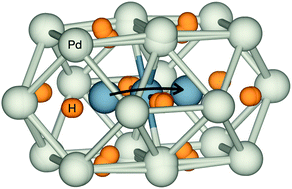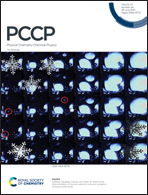Vacancy diffusion in palladium hydrides†
Abstract
The self-diffusion coefficients of palladium in PdHx (x = 0, 0.25, 0.5, 0.75, 1) were studied using density functional theory to obtain the required thermodynamic and kinetic parameters. The enthalpy of migration decreased from 0.95 eV for Pd to 0.78 eV for PdH. The enthalpy of vacancy formation exhibited a substantial decrease from about 1.1 eV in Pd to 0.4 eV in PdH, which was ascribed to successive filling of antibonding states weakening the Pd–Pd bonds. Concurrently, the Arrhenius pre-exponential was significantly reduced from 4.75 × 10−3 cm2 s−1 for Pd to 5.67 × 10−9 cm2 s−1 for PdH due to softening of the vibrational modes that determine the entropy of vacancy formation and initial/transition state frequencies. A linear correlation between the logarithm of the pre-exponential and the activation energy was interpreted as enthalpy–entropy compensation (Meyer–Neldel rule). The Pd self-diffusion coefficients in the hydrides were within 1 order of magnitude of that in pure palladium above 200 °C for hydrogen pressures up to at least 107 Pa.



 Please wait while we load your content...
Please wait while we load your content...